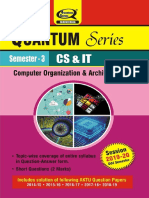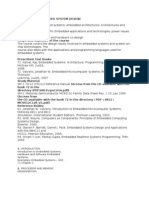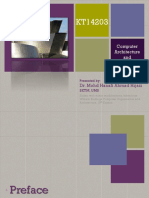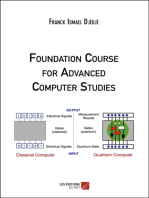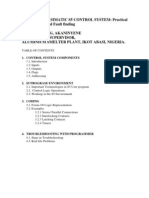Directorate of Technical Education, Goa State: (Co301) Computer Hardware
Directorate of Technical Education, Goa State: (Co301) Computer Hardware
Uploaded by
Pradhyumn P. S. TilveCopyright:
Available Formats
Directorate of Technical Education, Goa State: (Co301) Computer Hardware
Directorate of Technical Education, Goa State: (Co301) Computer Hardware
Uploaded by
Pradhyumn P. S. TilveOriginal Description:
Original Title
Copyright
Available Formats
Share this document
Did you find this document useful?
Is this content inappropriate?
Copyright:
Available Formats
Directorate of Technical Education, Goa State: (Co301) Computer Hardware
Directorate of Technical Education, Goa State: (Co301) Computer Hardware
Uploaded by
Pradhyumn P. S. TilveCopyright:
Available Formats
Directorate of Technical Education, Goa State
(CO301) COMPUTER HARDWARE
Rationale:
This course in computer hardware is meant to give the student an in depth exposure to the
working of a typical computer system. The physical structure and working of all that goes
inside the system unit is dealt with in this course. Students will be able to understand the
maze of events that take place inside the hardware ranging from the power supply to
motherboard and all peripherals.
TEACHING AND EXAMINATION SCHEME:
Course Code Examination Scheme
Periods/
& Week Total
Theory Marks Total
Credit Practical Marks
(In Hours) Marks
Course Title
CO301 L T P C TH TM TW PR/OR
COMPUTER 175
HARDWARE 3 - 2 5 75 25 25 50
DETAILED COURSE CONTENTS:
UNIT I
1 Personal Computer and Motherboard (15 Marks)
1.1 Main System Unit and Motherboard.
1.1.1 Front and Back panel of system unit its indicators, ports, connectors, jacks, sockets
and switches.
1.1.2 Motherboard and its Components
1.1.3 Different forms of motherboards- Intel and AMD
1.1.4 Motherboards, selection criteria and form factor.
1.2 Process Technologies-Dual Independent Bus Architecture, Hyper-threading Technology.
Processor Socket and Slots
1.3 Chipset Basics - Chipset Architecture, North/South Bridge Architecture, Hub
Architecture.
1.4 Overview and Features - PCI (Peripheral Component Interconnect), PCI-X (Peripheral
Component Interconnect Extended), PCI-Express, PCMCIA-(PC Card), AGP
(Accelerated Graphics Port) or (Advanced Graphics Port), Processor Bus (Front-Side
Bus), PCI versus PCI-Express.
1.5 BIOS- BIOS Basics, CMOS Setup basics
COMPUTER ENGG. CURRICULUM Page
45
Directorate of Technical Education, Goa State
UNIT II
2 Memory and Storage Devices and its Interfacing (15 Marks)
2.1 RAM, ROM types and physical organization (Simms, Dims, Rimm)
2.2 Cache Memory- cache memory, cache levels (L1, L2, L3, and L4).
2.3 Flash Memory
2.4 Construction and Working of Hard Disk drive-Sides or Heads, Track, Sectors, Cylinder,
Cluster, Sector Interleaving
2.5 Recording Techniques-Frequency Modulation (FM) Recording Techniques- MFM
Recording
Technique, RLL Recording (Run Length Limited)
2.6 Landing Zone, MBR (Master Boot Record), Zone Recording, Write Pre compensation
2.7 Hard Disk Drive Interface-IDE, SCSI, Parallel AT Attachment, Serial AT Attachment
2.8 Optical Storage: DVD-Digital Versatile Disc- Construction, Recording on DVD
2.9 Blue-ray Disk Specification.
UNIT III
3 Display Devices and Interfacing (15 Marks)
3.1 CRT Color Monitor and Characteristics, Advantages and Disadvantages
3.2 LCD Monitor (Liquid Crystal Display) - Functional Block Diagram of LCD Monitor,
Working
Principle or Working of LCD Monitor, Advantages and Disadvantages, Types of LCD,
Important Characteristics of LCD
3.3 Touch Screen Display
3.4 Plasma Display Technology
3.5 Video Accelerator Card
UNIT IV
4 Input and Output Devices (15 Marks)
4.1 Keyboard- Keyboard Operation, Keyboard Electronics, Types of Key switches,
Construction
and Working, Keyboard Interfacing, Keyboard Connectors.
4.2 Mouse- Types of Mouse, Construction of Mouse, Mechanical Mouse, Opto-Mechanical
Mouse
Optical Mouse
4.3 Scanner-Types of Scanner, Construction and Working of Scanner,
COMPUTER ENGG. CURRICULUM Page
46
Directorate of Technical Education, Goa State
4.4 Modem-Types of Modem, Specifications of Modem
4.5 Printer - Classification of Printer, Characteristics of Printer, Dot Matrix Printer, Inkjet
Printer,
Laser Printer
UNIT V
5 Power Supply and other Interfaces (15 Marks)
5.1 Block Diagram and Working of SMPS, SMPS Output Usage, Signal Description and
Pinout.
Diagram of AT and ATX Connectors, Power Supply Form Factor, Power Supply
Characteristics.
5.2 Uninterrupted Power Supply (UPS) -Types of UPS, Power Rating of UPS.
5.3 USB- USB Connectors, USB Features.
5.4 RS-232 (Recommended Standard - 232) -Different Voltage Levels used in RS-232, RS-
232
Signal Description, RS 232 Communication.
5.5 Centronics Interface-Signals from PC to Printer, Signals from Printer to PC
5.6 Bluetooth, Bluetooth Specifications.
Suggested List of Practicals:
Identification of front panel indicators and switches in a computer system of table
1.
top/ tower case model and also identification of rear side connectors.
Draw a Computer system layout and Mark the positions of SMPS, Mother Board,
2.
FDD, HDD, and CD-Drive/DVD-Drive add on cards
Study of Motherboard: Draw the layout of Pentium IV or Pentium Dual core or
Pentium Core2 DUO motherboard and mark Processor, Chip set ICs. RAM, Cache,
3.
cooling fan, I/O slots and I/O ports and various jumper settings. (Latest Chipset of
PC-Intel P67 Chipset, Intel H67 Chipset, G31 chip set, G45 chip set.)
Study of CMOS Setup Program: 1. Changing the Standard settings 2. Changing
4.
advanced settings (BIOS and Chipset features)
5. Study of various cards used in system.
6. Study the installation and Re-installation of HDD.
7. Study the installation and Re-installation of CD ROM Drive
8. Study of SMPS Unit. Check and measure various supply voltages.
9. Study of Keyboard and mouse
Study of Display system.
10.
COMPUTER ENGG. CURRICULUM Page
47
Directorate of Technical Education, Goa State
Study of Printer Installation & scanner installation
11.
Study of RS232 serial interface, Centronic
12.
Assembling a PC: Assemble a Pentium IV or Pentium Dual Core Pentium Core2
13. Duo system with necessary peripherals and check the working condition of the PC.
Text Books:
1) PC Hardware: The Complete Reference 1st Edition , Author: CRAIG ZACKER,
Publisher: MCGRAW-HILL EDUCATION (INDIA) LTD (2001)
2) Modern Computer Hardware course by Manahar Lotia, Pradeep Nair,Payal Lotia
3) COMPUTER HARDWARE & MAINTENANCE by Author: Sunita Velapure,
Snehal Rane
COMPUTER ENGG. CURRICULUM Page
48
You might also like
- (FREE PDF Sample) A AS Level Computer Science For OCR Student Book A Level Comp 2 Computer Science OCR Alistair Surrall EbooksDocument62 pages(FREE PDF Sample) A AS Level Computer Science For OCR Student Book A Level Comp 2 Computer Science OCR Alistair Surrall Ebookskontskoric100% (7)
- How To Use CAN Toolhead Boards Connected Directly To OctopusDocument25 pagesHow To Use CAN Toolhead Boards Connected Directly To Octopush2oo2hNo ratings yet
- Quantum COADocument293 pagesQuantum COAAnshika Chauhan88% (17)
- Software Architecture Course NotesDocument90 pagesSoftware Architecture Course NotesIrphan ZamindarNo ratings yet
- EE450 SocketProgrammingProject Fall2015Document25 pagesEE450 SocketProgrammingProject Fall2015nikhilnarangNo ratings yet
- CMTSDocument8 pagesCMTSvjmakwanaNo ratings yet
- Computer Hardware and ServicingDocument232 pagesComputer Hardware and ServicingrajeevNo ratings yet
- Legends: L-Lecture T - Tutorial/Teacher Guided Theory Practice P - Practical C - Credit ESE - EndDocument9 pagesLegends: L-Lecture T - Tutorial/Teacher Guided Theory Practice P - Practical C - Credit ESE - EndPradip SodhaNo ratings yet
- Bca-Vi Sem-Pc HW and Network-SylDocument6 pagesBca-Vi Sem-Pc HW and Network-Syllo leeeNo ratings yet
- Lecture Notes Computer Hardware and MaintenanceDocument79 pagesLecture Notes Computer Hardware and MaintenanceSaeedNo ratings yet
- Module 1Document53 pagesModule 1tarunkumarsj117No ratings yet
- Computer Hardware Maintanance Repair1Document32 pagesComputer Hardware Maintanance Repair1wolefpcloudNo ratings yet
- Chapter 1 Typical Configuration of ComputerDocument13 pagesChapter 1 Typical Configuration of Computerthejassurya24707No ratings yet
- Computer Hardware& MaintenanceDocument79 pagesComputer Hardware& Maintenancelakshmanbm8No ratings yet
- ECE4434250620161172Notes 22Document5 pagesECE4434250620161172Notes 22yash vihariNo ratings yet
- Training SylabusDocument14 pagesTraining Sylabussachinsharmaji1989No ratings yet
- Rationale: Course Title: Computer Hardware and Networking Course Code: Periods/Week: 4 Periods/Semester: 64Document5 pagesRationale: Course Title: Computer Hardware and Networking Course Code: Periods/Week: 4 Periods/Semester: 64Unaise EkNo ratings yet
- MattDocument7 pagesMattSalwa A AliNo ratings yet
- Embedded System Course Code: 3361105Document7 pagesEmbedded System Course Code: 3361105Salwa A AliNo ratings yet
- Embedded System Course Code: 3361105Document7 pagesEmbedded System Course Code: 3361105Salwa A AliNo ratings yet
- Chapter 1 - Introduction To The Personal ComputerDocument26 pagesChapter 1 - Introduction To The Personal ComputerLaye Doki AhmadouNo ratings yet
- Computer Hardware and Maintenance (9089)Document7 pagesComputer Hardware and Maintenance (9089)Suman Ghosh100% (1)
- Computer NetworksDocument452 pagesComputer NetworksCopereal CoperealNo ratings yet
- CoaDocument293 pagesCoaRaj aryanNo ratings yet
- ICPCH Lesson PlanDocument4 pagesICPCH Lesson Planalishyaantony22No ratings yet
- Silver Oak University: This Course Provides Detail of A Computer System's Functional Components, TheirDocument3 pagesSilver Oak University: This Course Provides Detail of A Computer System's Functional Components, Theirkgajjar336No ratings yet
- ICHPDocument2 pagesICHPbhagy finaviyaNo ratings yet
- 1ST Term Ict Lesson Notes For Week 1Document12 pages1ST Term Ict Lesson Notes For Week 1HalifaxNo ratings yet
- Part 1 Computer Software Application ModuleDocument56 pagesPart 1 Computer Software Application ModuleJenny Mae OrillaNo ratings yet
- DCA2203 - System Software Merged Sem 4thDocument424 pagesDCA2203 - System Software Merged Sem 4thadobeindustrialsystemsNo ratings yet
- Comp 5Document19 pagesComp 5gurmeetsinghbhurwalNo ratings yet
- Microprocessor 4th SemDocument316 pagesMicroprocessor 4th SemDaggupatiHarishNo ratings yet
- Notes For CAE-1 - All TopicsDocument60 pagesNotes For CAE-1 - All Topicsplantforest16No ratings yet
- Syllabus&Reference Text BooksDocument4 pagesSyllabus&Reference Text BooksRamakrishnaRao SoogooriNo ratings yet
- ELEC3300 - 03-Embedded System StructureDocument27 pagesELEC3300 - 03-Embedded System StructureKwun Hok ChongNo ratings yet
- Computer Science NotesDocument342 pagesComputer Science Noteslexome1525No ratings yet
- ComputerDocument227 pagesComputerggvuedNo ratings yet
- Chapter 1 Typical Configuration of ComputerDocument13 pagesChapter 1 Typical Configuration of ComputerYou Are Not Wasting TIME Here100% (3)
- COA HANDOUT - ModifiedDocument20 pagesCOA HANDOUT - ModifiedVani telluriNo ratings yet
- Computer Architecture and Organization: Dr. Mohd Hanafi Ahmad HijaziDocument34 pagesComputer Architecture and Organization: Dr. Mohd Hanafi Ahmad HijaziMae XNo ratings yet
- Rs1043 - Computer Engineering Curriculum Grade 11 and 12Document25 pagesRs1043 - Computer Engineering Curriculum Grade 11 and 12kalu SAHNo ratings yet
- PHSDocument215 pagesPHSrosekatheNo ratings yet
- assignDocument11 pagesassignrhisavmukherjee21No ratings yet
- 192 - Final - Fundamentals of ComputerDocument67 pages192 - Final - Fundamentals of Computerskdash728No ratings yet
- 3139 HW SyllabusDocument4 pages3139 HW SyllabusSajeev SbceNo ratings yet
- 10CS45 - MicroprocessorsDocument1 page10CS45 - MicroprocessorsnandanvrNo ratings yet
- Itws ManualDocument98 pagesItws Manualapi-291463406No ratings yet
- G11 - Module 2Document19 pagesG11 - Module 2Daniel Daryl CalingNo ratings yet
- μP syllabusDocument3 pagesμP syllabusts320244No ratings yet
- Curriculum of Ten Plus Two in Computer Engineering PDFDocument24 pagesCurriculum of Ten Plus Two in Computer Engineering PDFOTAKU GAMINGNo ratings yet
- TriGem CognacDocument29 pagesTriGem CognacfostechNo ratings yet
- Hub Digital LTD: Assignment 1: (Hand in Date W/C 1/12/2008)Document11 pagesHub Digital LTD: Assignment 1: (Hand in Date W/C 1/12/2008)Ben RidleyNo ratings yet
- Sem5 EJ5EDocument38 pagesSem5 EJ5EAjit SinghNo ratings yet
- Ics 2101 Bit 2102 First BatchDocument23 pagesIcs 2101 Bit 2102 First BatchmohezlonkanoNo ratings yet
- Computer Hardware and Servicing Semester 6 Text BooksDocument232 pagesComputer Hardware and Servicing Semester 6 Text Bookstrw.dcnNo ratings yet
- Rajagiri School of Engineering and TechnologyDocument44 pagesRajagiri School of Engineering and TechnologyBennet MathewNo ratings yet
- MSCANCS Semester-1Document18 pagesMSCANCS Semester-1shawankit135No ratings yet
- Cse IV Computer Organization (10cs46) NotesDocument214 pagesCse IV Computer Organization (10cs46) NotesRajesh KannaNo ratings yet
- PLC: Programmable Logic Controller – Arktika.: EXPERIMENTAL PRODUCT BASED ON CPLD.From EverandPLC: Programmable Logic Controller – Arktika.: EXPERIMENTAL PRODUCT BASED ON CPLD.No ratings yet
- The complete guide to Hardware Technician Terminology: A simplified guideFrom EverandThe complete guide to Hardware Technician Terminology: A simplified guideNo ratings yet
- FPGA Programming for Beginners: Bring your ideas to life by creating hardware designs and electronic circuits with SystemVerilogFrom EverandFPGA Programming for Beginners: Bring your ideas to life by creating hardware designs and electronic circuits with SystemVerilogNo ratings yet
- Digital Electronics, Computer Architecture and Microprocessor Design PrinciplesFrom EverandDigital Electronics, Computer Architecture and Microprocessor Design PrinciplesNo ratings yet
- Download Full The Garbage Collection Handbook. The Art of Automatic Memory Management, 2nd Richard Jones PDF All ChaptersDocument50 pagesDownload Full The Garbage Collection Handbook. The Art of Automatic Memory Management, 2nd Richard Jones PDF All Chaptersleugaubaid7y100% (1)
- RS& GIS UNIT - 2Document35 pagesRS& GIS UNIT - 2rockchandu243No ratings yet
- Mahadevan, Freeman, Magerko - An Interactive, Graphical Coding Environment For EarSketch Online Using Blockly and Web Audio APIDocument4 pagesMahadevan, Freeman, Magerko - An Interactive, Graphical Coding Environment For EarSketch Online Using Blockly and Web Audio APIPaoloNo ratings yet
- Midi InterfaceDocument20 pagesMidi InterfaceemcoNo ratings yet
- Tutorial On Simatic s5 Control System :practical Programming and Fault FindingDocument22 pagesTutorial On Simatic s5 Control System :practical Programming and Fault Findingak4dili80% (5)
- CO Unit 1 PDFDocument84 pagesCO Unit 1 PDFTejaswini PydiNo ratings yet
- 02 134221 083 10676495395 30032023 100026amDocument5 pages02 134221 083 10676495395 30032023 100026ammagnesium 123No ratings yet
- 820-1540, 051-6482, MLB (GILA EVT1) Rev 13, 11.21.2003Document70 pages820-1540, 051-6482, MLB (GILA EVT1) Rev 13, 11.21.2003aplus guideNo ratings yet
- Keyboard Shortcuts - Mac GuidesDocument9 pagesKeyboard Shortcuts - Mac GuidesKaloy KamaoNo ratings yet
- CCDA Python HandsOn IPRouteDocument4 pagesCCDA Python HandsOn IPRoutesolarious cellaNo ratings yet
- LabDocument169 pagesLabKothapalli Venkata RaoNo ratings yet
- Novelwriter-2 1Document91 pagesNovelwriter-2 1Arnaud TISSIENo ratings yet
- Zsjeg-Lab051pr10 A0103Document25 pagesZsjeg-Lab051pr10 A0103Riza VirsadaNo ratings yet
- Pic16 (L) F15089 PDFDocument418 pagesPic16 (L) F15089 PDFWarr SteelNo ratings yet
- Introduction To Network DistributorsDocument5 pagesIntroduction To Network DistributorsHakim AzmanNo ratings yet
- SanPedro 05 Laboratory Exercise 1Document3 pagesSanPedro 05 Laboratory Exercise 1Edison Jr. Gaudicos100% (1)
- Aplikasi Kriptografi Keamanan Komputer "Rc4Engine With Java-Netbeans"Document3 pagesAplikasi Kriptografi Keamanan Komputer "Rc4Engine With Java-Netbeans"Dmaz Krewol Pengen GenahNo ratings yet
- HunterLab ColorQUEST II Manual 2020424163339Document185 pagesHunterLab ColorQUEST II Manual 2020424163339heresy.000.m31No ratings yet
- MS-DOS CommandsDocument3 pagesMS-DOS Commandsmarciano_meNo ratings yet
- Ms WindowsDocument13 pagesMs WindowsVIJOY DOBRIALNo ratings yet
- 3.13 How To Clean Your CodeDocument4 pages3.13 How To Clean Your Codejuan gutierrezNo ratings yet
- MT5 Guide - EnglishDocument10 pagesMT5 Guide - EnglishThe Trading PitNo ratings yet
- Loops in Python: CH - SrilakshmiDocument44 pagesLoops in Python: CH - SrilakshmiSridevi Women's Engineering College Department of EIENo ratings yet
- Linux Commands-File PermissionsDocument49 pagesLinux Commands-File Permissions13g31d1708No ratings yet
- 3android Kotlin - Android Threading and AsyncTaskDocument33 pages3android Kotlin - Android Threading and AsyncTaskمحمد صباحNo ratings yet
- Lab04 - SysinstDocument22 pagesLab04 - SysinstWeam AlzhraniNo ratings yet
- Hyper-Threading Technology Architecture and Microarchitecture - SummaryDocument4 pagesHyper-Threading Technology Architecture and Microarchitecture - SummaryMuhammad UsmanNo ratings yet


